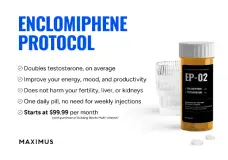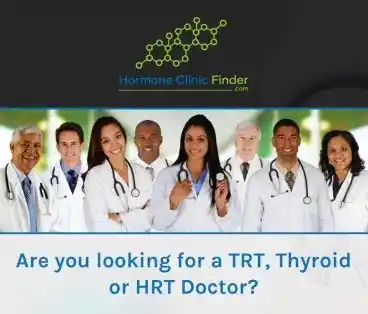madman
Super Moderator
Author Block: Petra E. Pederson, MD, PhD1, Jeremy Winkelman, MD1, Michelle Wong, MD1, Leah Puglisi, MS2, Matthew Jason Levine, MD, FACE3. 1Scripps Clinic/Scripps Green Hospital, La Jolla, CA, USA, 2Scripps Hub Academic Research Core (SHARC)/Scripps Health, San Diego, CA, USA, 3Scripps Clinic/Division of Endocrinology, La Jolla, CA, USA.
Disclosure Block: P.E. Pederson: None. J. Winkelman:None. M. Wong: None. L. Puglisi: None. M.J. Levine: None.
Background
Prescriptions for testosterone replacement therapy (TRT) for male hypogonadism have increased over recent decades in association with increased direct-to-consumer advertising (DTCA). Despite publication of evidence-based guidelines in 2018, inappropriate treatment by online and “boutique” clinics remains prevalent. Our study aims to assess adherence to guidelines by primary care providers (PCPs) compared to specialists (endocrinologists and urologists) within our health system and identify the provider perceived prevalence of this problem and barriers to providing evidence-based care.
Methods
A retrospective chart review identified 269 adult male patients initiated on TRT between 2019 and 2023. Guideline adherence, including confirmatory testing with two low AM total or free testosterone levels and testing for etiology, was compared between PCPs and specialists. In addition, a survey of providers was conducted regarding their experiences with TRT. Comparisons between groups were made using chi-square test of independence or Fisher’s Exact test.
Results
Of the 269 TRT prescriptions identified, 181 (67.3%) were from PCPs, 67 (24.9%) urologists, and 21 (7.8%) endocrinologists. Only 25 (9.3%) patients had two low AM testosterone levels prior to initiating TRT, with no significant difference between PCPs and specialists (7.2% vs 13.6%, p = 0.359). PCPs were more likely to initiate TRT without any low testosterone levels compared to specialists (21.5% vs 10.2%, p = 0.023). Specialists ordered LH and FSH testing more than PCPs, however the difference was not significant (33% vs 23.2%, p = 0.089; 27.3% vs 19.3%, p=0.14). Among specialists, endocrinologists obtained two low AM testosterone levels prior to TRT initiation more often than urologists (42.9% vs 4.5%, p = 0.0012), and similarly for LH and FSH (85.7% vs 16.4%, p = 0.001; 66.7% vs 14.9%, p < 0.001). Survey data from 51 providers revealed 100% of providers had at least one TRT request in the last 6 months and 74.5% felt DTCA was a public health issue.
Conclusion
This study suggests that most patients did not receive appropriate workup before starting TRT, unnecessarily exposing them to potential adverse effects. The disparity between specialists and PCPs suggests a knowledge gap among providers. Striking differences were also noted between urologists and endocrinologists, which may be due to the greater volume of patients with sexual dysfunction presenting to urology compared to endocrinology. Our survey revealed most providers have concerns regarding DTCA and the prevalence of misinformation regarding TRT. A limitation of this study is its restriction to one region and health system. The effect of DTCA on TRT prescribing practices is still unclear, requiring further research. Regardless, this data can guide quality improvement initiatives on appropriate laboratory testing to promote safe and evidence-based care.
 myadlm.org
myadlm.org
Bob Barrett:
Well, finally, looking ahead, what kind of research do you think is needed to ensure that guidelines and clinical practices align with the latest evidence on testosterone measurement?
Adith Arun:
Yeah, that’s a great question, Bob. And I think there are a few different cutoffs out there by different bodies, which you highlighted earlier in our conversation. And I think the first step is to try to...
Disclosure Block: P.E. Pederson: None. J. Winkelman:None. M. Wong: None. L. Puglisi: None. M.J. Levine: None.
Background
Prescriptions for testosterone replacement therapy (TRT) for male hypogonadism have increased over recent decades in association with increased direct-to-consumer advertising (DTCA). Despite publication of evidence-based guidelines in 2018, inappropriate treatment by online and “boutique” clinics remains prevalent. Our study aims to assess adherence to guidelines by primary care providers (PCPs) compared to specialists (endocrinologists and urologists) within our health system and identify the provider perceived prevalence of this problem and barriers to providing evidence-based care.
Methods
A retrospective chart review identified 269 adult male patients initiated on TRT between 2019 and 2023. Guideline adherence, including confirmatory testing with two low AM total or free testosterone levels and testing for etiology, was compared between PCPs and specialists. In addition, a survey of providers was conducted regarding their experiences with TRT. Comparisons between groups were made using chi-square test of independence or Fisher’s Exact test.
Results
Of the 269 TRT prescriptions identified, 181 (67.3%) were from PCPs, 67 (24.9%) urologists, and 21 (7.8%) endocrinologists. Only 25 (9.3%) patients had two low AM testosterone levels prior to initiating TRT, with no significant difference between PCPs and specialists (7.2% vs 13.6%, p = 0.359). PCPs were more likely to initiate TRT without any low testosterone levels compared to specialists (21.5% vs 10.2%, p = 0.023). Specialists ordered LH and FSH testing more than PCPs, however the difference was not significant (33% vs 23.2%, p = 0.089; 27.3% vs 19.3%, p=0.14). Among specialists, endocrinologists obtained two low AM testosterone levels prior to TRT initiation more often than urologists (42.9% vs 4.5%, p = 0.0012), and similarly for LH and FSH (85.7% vs 16.4%, p = 0.001; 66.7% vs 14.9%, p < 0.001). Survey data from 51 providers revealed 100% of providers had at least one TRT request in the last 6 months and 74.5% felt DTCA was a public health issue.
Conclusion
This study suggests that most patients did not receive appropriate workup before starting TRT, unnecessarily exposing them to potential adverse effects. The disparity between specialists and PCPs suggests a knowledge gap among providers. Striking differences were also noted between urologists and endocrinologists, which may be due to the greater volume of patients with sexual dysfunction presenting to urology compared to endocrinology. Our survey revealed most providers have concerns regarding DTCA and the prevalence of misinformation regarding TRT. A limitation of this study is its restriction to one region and health system. The effect of DTCA on TRT prescribing practices is still unclear, requiring further research. Regardless, this data can guide quality improvement initiatives on appropriate laboratory testing to promote safe and evidence-based care.
Reevaluating the threshold for low total testosterone
In this podcast, Adith Arun from the Yale New Haven Hospital Center for Outcomes Research and Evaluation, and a third year medical student at the Yale School of Medicine, discusses a letter to the editor, “Reevaluating the threshold for low total testosterone,” published in the May 2025 issue of...
Bob Barrett:
Well, finally, looking ahead, what kind of research do you think is needed to ensure that guidelines and clinical practices align with the latest evidence on testosterone measurement?
Adith Arun:
Yeah, that’s a great question, Bob. And I think there are a few different cutoffs out there by different bodies, which you highlighted earlier in our conversation. And I think the first step is to try to...
- madman
- hypogonadism; t assays; standardized/harmonized
- Replies: 1
- Forum: Testosterone and Men's Health Articles















